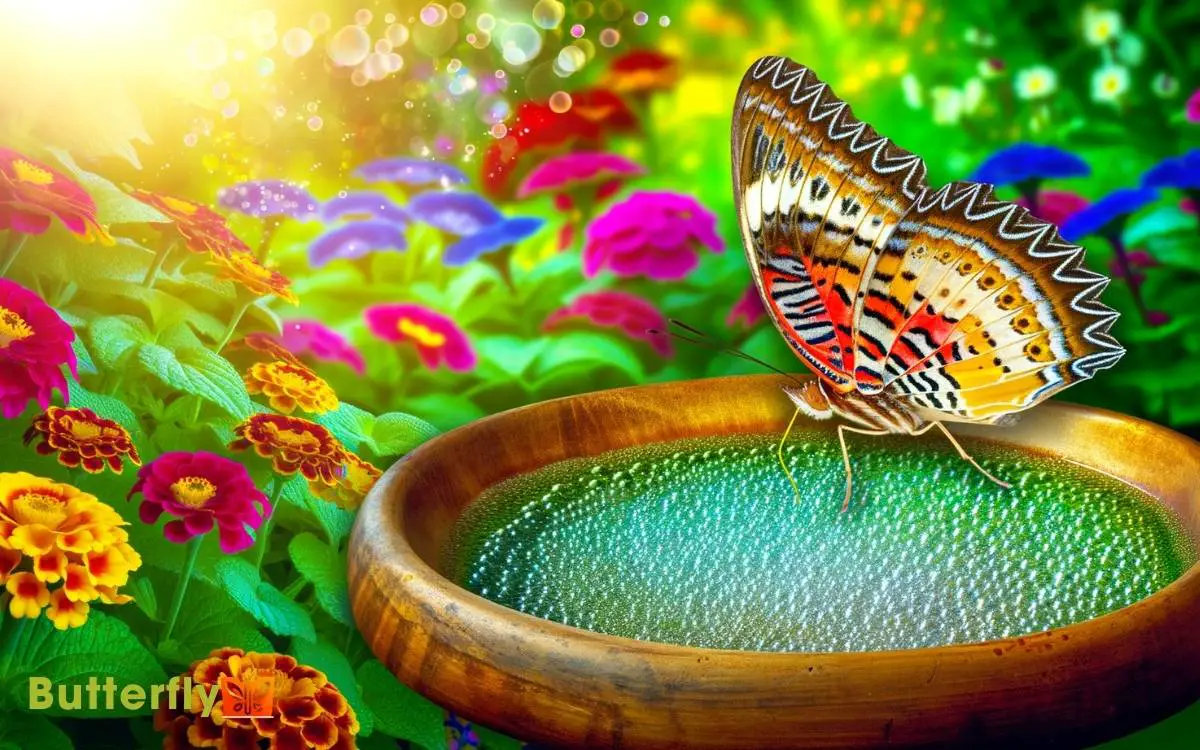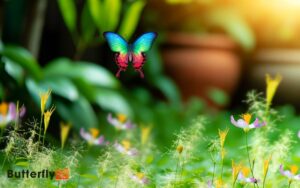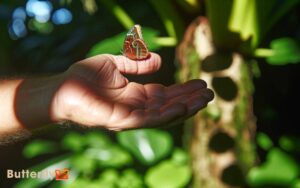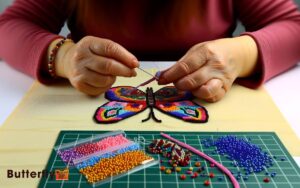How To Feed Butterflies With Sugar Water? A Complete Guide!
To feed butterflies with sugar water, mix a 1:4 ratio of granulated sugar to water and stir until it’s fully dissolved.
Use a clean, shallow, non-porous dish, ideally in bright colors, and place it in a shaded area. Saturate a natural sponge with the sugar solution and inspect it regularly for mold.
Position the feeder in a sunny, sheltered spot, and near nectar-rich plants. Clean the feeder every few days using a mild bleach solution.
Considering these steps will help you create an inviting environment for butterflies. Continue exploring to enhance your butterfly-friendly garden further.

Key Takeaways
Gather Your Supplies
You’ll need to gather essential supplies, including a shallow dish, granulated sugar, and clean water, to begin feeding butterflies with sugar water.
Start by selecting a shallow dish that allows easy access for butterflies. This dish should be clean and free of any contaminants.
Next, measure out granulated sugar using a precise ratio: one part sugar to four parts water. This concentration mimics the natural nectar found in flowers, ensuring butterflies receive the necessary nutrients.
Use clean, preferably distilled water to avoid introducing impurities. Stir the mixture thoroughly until the sugar dissolves completely.
Choose the Right Container
Selecting the appropriate container for your sugar water is crucial to guarantee butterflies can feed comfortably and safely. Opt for a shallow dish or saucer to minimize the risk of drowning.
Use non-porous materials like glass or plastic to prevent contamination. Ensure the container has a rough surface or place a sponge inside; this provides footing and mimics natural feeding conditions.
Choose a container with bright colors to attract butterflies, such as red or yellow. If you’re designing an innovative feeder, consider incorporating small, perforated platforms or mesh to allow proboscis access while reducing solution evaporation.
Position the container in a shaded area to regulate temperature and prevent rapid sugar degradation.
Mix the Sugar Water
To create the best sugar water mixture, combine one part granulated sugar with four parts water, making sure the sugar fully dissolves. Use hot water to accelerate dissolution; this guarantees a homogenous solution, crucial for consistent feeding.
Measure the sugar and water accurately with a kitchen scale and a graduated cylinder for precision. Stir the mixture continuously until no sugar crystals remain. Let the solution cool to room temperature before use.
This precise ratio mimics natural nectar concentration, optimizing butterfly health. Store any unused solution in a sealed container in the refrigerator, but discard after a week to prevent microbial growth.
This meticulous approach ensures you provide a high-quality, scientifically-sound feeding solution for your butterflies.
Add a Feeding Sponge
To guarantee your butterflies can easily access the sugar water, you’ll need to select suitable sponges that are non-toxic and absorbent.
Once you’ve prepared the sugar solution, thoroughly saturate the sponge to provide a consistent feeding source.
Choosing Suitable Sponges
When selecting suitable sponges for feeding butterflies, opt for those made of natural materials to guarantee they can safely absorb and hold sugar water.
Natural sponges, like sea sponges, offer an ideal structure with their porous texture, allowing butterflies to feed effectively.
Avoid synthetic sponges, as they may contain harmful chemicals that could be detrimental to the butterflies.
Choose sponges free from dyes and additives to make certain of a pure feeding environment. Cut the sponges into manageable sizes, ensuring they fit comfortably in your feeding station.
Regularly inspect the sponges for mold or mildew, as these can harm butterflies. By selecting the right sponge, you provide a safe, efficient feeding surface that fosters the well-being of your butterflies.
Preparing the Sugar Solution
Begin by dissolving one part granulated sugar in four parts warm water, making sure the sugar fully integrates into the solution.
This creates a perfect sugar concentration that closely mimics the nectar found in flowers. Use a clean container to mix, stirring until no sugar granules remain visible.
To enhance the feeding process, add a feeding sponge. The sponge acts as a wick, drawing the sugar solution to its surface, where butterflies can easily sip.
Guarantee the sponge is sterile and free from contaminants, which could harm the butterflies. Place the sponge in the solution, allowing it to absorb fully.
| Step | Description |
|---|---|
| Dissolve | Mix sugar and water until fully integrated |
| Sterilize | Ensure feeding sponge is clean and contaminant-free |
| Absorb | Place sponge in solution to allow complete absorption |
Placing the Feeding Sponge
Carefully place the feeding sponge into the sugar solution, ensuring it remains fully submerged and properly absorbs the mixture. Use a sterile sponge to prevent contamination. By doing so, you create an efficient feeding surface that mimics natural nectar sources.
Position the sponge in a shallow dish to avoid drowning hazards for the butterflies. Make sure the dish is clean and free of any harmful residues.
Monitor the sponge’s saturation level regularly; it should stay moist but not overly saturated to prevent mold growth. Placing the dish in a well-lit area encourages butterfly visitation.
Place the Feeder in Your Garden
You should place the feeder in a sunny, sheltered spot in your garden to attract more butterflies.
Position it near nectar-rich plants to enhance its effectiveness.
This strategic location will maximize butterfly visits and provide additional benefits for your garden’s ecosystem.
Feeder Placement Tips
To maximize butterfly visits, place the feeder in a sunny spot within your garden where it’s sheltered from strong winds.
Light exposure is essential, as butterflies are ectothermic and rely on external warmth to stay active. Avoid areas that receive excessive shade or are prone to gusty conditions, which can disorient and deter butterflies.
Position the feeder at a height of three to four feet above the ground. This height optimizes visibility while mimicking natural feeding conditions.
Make sure the feeder is accessible yet protected from predators. Anchoring the feeder near nectar-rich plants can enhance the feeding experience.
Regularly inspect the feeder for cleanliness and replenish sugar water as needed to maintain a reliable food source.
Attracting More Butterflies
Positioning the feeder strategically in your garden can greatly boost the number of butterfly visitors and enhance their feeding experience.
To achieve this, consider the following:
- Proximity to Nectar-rich Flowers: Place your feeder near clusters of nectar-rich flowers like milkweed and coneflowers. This not only attracts butterflies but also provides them with a natural food source.
- Sun Exposure: Guarantee the feeder is in a sunny spot. Butterflies are cold-blooded and rely on sunlight to regulate their body temperature, making sunlit areas more inviting.
- Height and Visibility: Position the feeder at a height where it’s easily visible to butterflies but safe from predators. Typically, placing it around waist height works well.
These precise tactics will optimize your butterfly feeder’s effectiveness, drawing in more visitors.
Garden Location Benefits
Placing the butterfly feeder in your garden provides a controlled environment that maximizes the availability of nourishment while supporting the local ecosystem.
Your garden’s microhabitat allows precise control over feeder placement, ensuring ideal sunlight exposure and avoiding harsh wind conditions.
Position the feeder near flowering plants to create a synergistic effect, enhancing nectar availability and attracting more butterflies. Utilize native plants to foster a balanced ecosystem, promoting biodiversity and resilience.
By integrating the feeder into your garden, you’re not just feeding butterflies; you’re contributing to pollination and ecological stability. Regularly monitor and adjust the feeder’s position based on seasonal changes and butterfly activity to maintain an inviting habitat.
This innovative approach supports conservation and offers observational opportunities.
Monitor and Refill the Feeder
Regularly check the feeder to make sure it remains filled with fresh sugar water, as this consistency is essential for attracting and nourishing butterflies effectively.
You should monitor the feeder daily, especially during hot weather, when the sugar water can evaporate quickly. Observe the level of sugar water and refill as needed to maintain a constant supply.
- Assess the sugar water freshness: Guarantee the solution is clear and free of debris.
- Monitor butterfly activity: Increased visits might require more frequent refills.
- Track environmental factors: High temperatures and wind can deplete the feeder faster.
Clean the Feeder Regularly
You must clean the feeder regularly to remove residue that accumulates from the sugar water. This vital step prevents mold growth, which can harm the butterflies.
Use a mild bleach solution to sanitize the feeder, ensuring it’s thoroughly rinsed before refilling.
Remove Residue Frequently
To safeguard the health and longevity of the butterflies, meticulously clean the feeder every few days to remove any accumulated residue. Residue buildup can attract harmful bacteria and deter butterflies from feeding.
Use a mild soap and warm water to scrub the feeder, making sure you rinse thoroughly to eliminate any soap traces. Pay special attention to the feeder’s crevices and seams where residue could hide.
Key steps include:
- Disassemble the feeder: This guarantees you can reach all parts and clean thoroughly.
- Inspect for residue: Check for any sticky or discolored areas that need extra attention.
- Dry completely: Before reassembling, make sure all parts are thoroughly dried to prevent any moisture-related issues.
Regular cleaning maintains a healthy feeding environment, promoting butterfly well-being.
Prevent Mold Growth
While maintaining a clean feeder to remove residue, it’s equally important to clean regularly to prevent mold growth, which can be detrimental to butterflies.
To guarantee ideal sanitation, rinse the feeder with a solution of one part white vinegar to four parts water. This natural, non-toxic cleaner effectively eliminates mold spores without harming butterflies.
After soaking for 15 minutes, scrub all surfaces with a soft brush, focusing on crevices where mold can thrive. Rinse thoroughly with hot water and let it air dry completely before refilling.
Regular maintenance every 3-5 days will keep mold at bay and provide a safe feeding environment. By adopting these practices, you’re fostering a healthier habitat for your butterfly visitors.
Plant Butterfly-Friendly Flowers
Choosing the right butterfly-friendly flowers guarantees that these delicate insects receive the necessary nectar and habitat they need to thrive.
Opt for native flowering plants, as they’re naturally adapted to your local climate and soil conditions, ensuring year-round sustenance for butterflies.
Here are three highly recommended choices:
- Milkweed (Asclepias spp.): Essential for monarch butterflies, providing both nectar and larval food.
- Coneflowers (Echinacea spp.): Known for their robust nectar production and long-lasting blooms.
- Lantana (Lantana camara): Offers a vibrant array of colors and continuous flowering, attracting various butterfly species.
Provide Shelter and Water
Providing shelter and a consistent water source guarantees butterflies have a safe haven and hydration, which are essential for their survival and well-being.
Construct a butterfly house using untreated wood, ensuring it has narrow slits for entry. Position it in a shaded, wind-protected area.
Use rocks or shallow dishes filled with water to create hydration stations. Add sponges to these containers; they help butterflies drink without the risk of drowning. You can also install a drip irrigation system to keep the water supply fresh.
To enhance the habitat, plant dense shrubs and trees nearby, providing both shelter and microclimates. This innovative approach creates an oasis, fostering a thriving butterfly population in your garden. Additionally, incorporating a variety of nectar-rich flowers ensures a continuous food source throughout the seasons. If you’re wondering how to get butterfly bush seeds, consider collecting them from mature blooms or purchasing them from a reputable nursery. With proper care and strategic planting, your garden can become a sanctuary for butterflies and other pollinators.
Avoid Pesticides
Removing pesticides from your garden is essential for protecting butterflies from harmful chemicals that can disrupt their life cycles and habitats. Pesticides can hinder their ability to reproduce and find food, leading to population declines.
Instead, you can adopt innovative, eco-friendly methods to manage pests.
- Introduce Beneficial Insects: Ladybugs and lacewings can naturally control aphids and other harmful pests.
- Use Neem Oil: This natural pesticide is less toxic and can effectively deter unwanted insects without harming butterflies.
- Implement Companion Planting: Planting marigolds and nasturtiums can repel pests while attracting beneficial insects.
Observe and Enjoy
By creating a butterfly-friendly environment, you’ll have the opportunity to observe these delicate insects up close, noting their feeding behaviors and interactions with various plants.
Watch as butterflies extend their proboscis to sip sugar water, an intricate process that reveals their adaptive feeding mechanisms.
Notice the preference they show for certain flowers and how they communicate through subtle wing movements. Documenting these behaviors can contribute valuable data to citizen science projects, enhancing our understanding of butterfly ecology.
For an innovative touch, consider using time-lapse photography or digital sensors to monitor feeding patterns. This scientific approach not only enriches your experience but also supports butterfly conservation efforts by providing critical insights into their habits and needs.
Conclusion
By feeding butterflies with sugar water, you’re guaranteeing their habitat, supporting their lifecycle, and fostering biodiversity.
You’ve learned to gather supplies, mix sugar water, and add a sponge.
You’ve placed feeders, planted flowers, and secured shelter and water.
You’ve avoided pesticides and contributed to a thriving ecosystem.
Observe the fluttering wings, marvel at their beauty, and relish in your contribution to nature’s delicate balance.
Your garden is now a sanctuary for these magnificent creatures.







Also visit my web site; https://cryptolake.online/crypto8
Central bank digital currency news